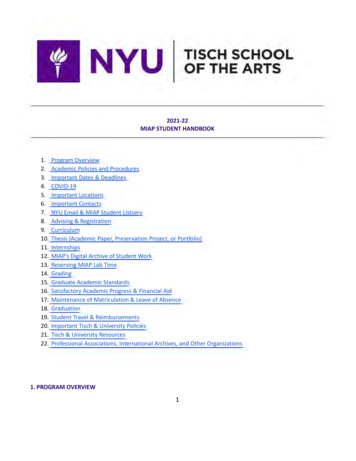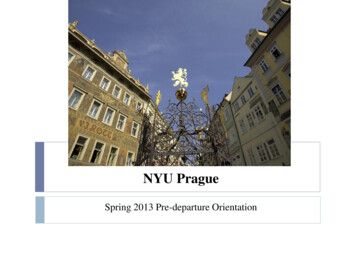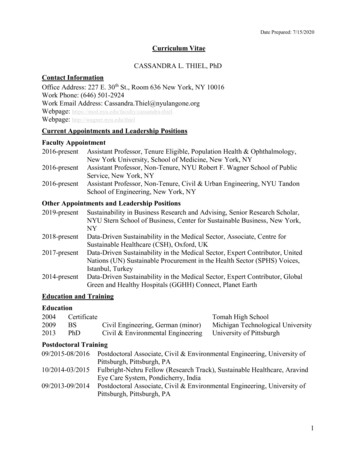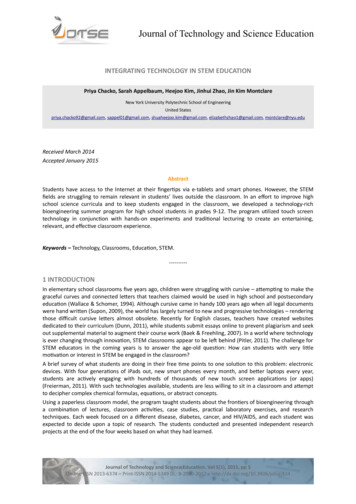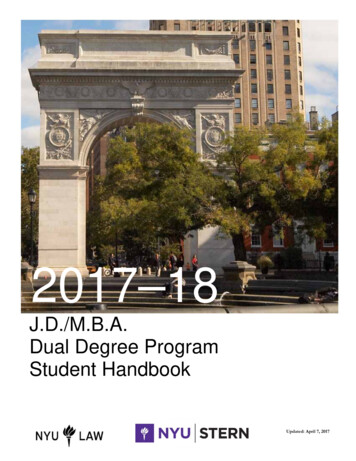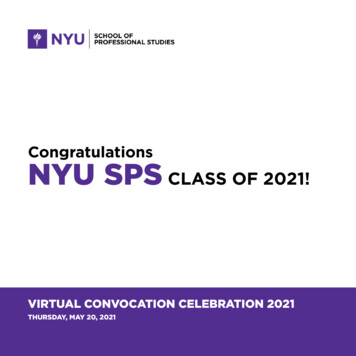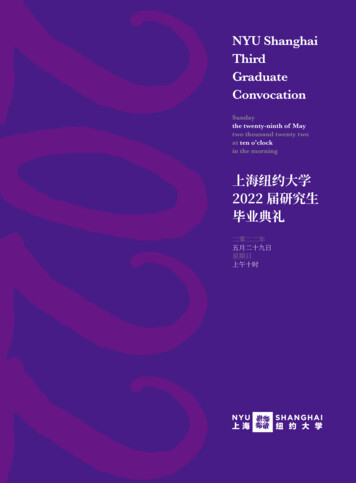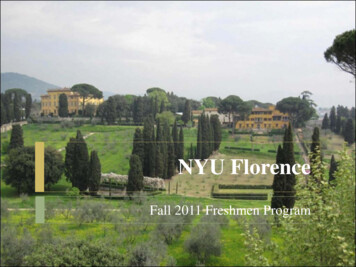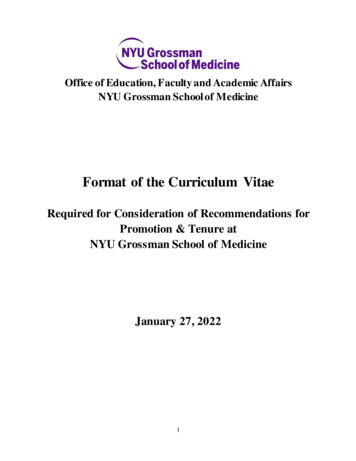
Transcription
CURRICULUM VITAETHOMAS R. ELLIOTT ott@nyu.edulast update: 20 July 2021(some professional activities prior to 2016 are missing)EDUCATION AND DEGREES Ph.D. 2004: Ancient History, University of North Carolina at Chapel Hill (UNC-CH). Dissertation: EpigraphicEvidence for Boundary Disputes in the Roman Empire.M.A. 1997: Ancient History, UNC-CH. Second field: Spatial Analysis. Thesis: Diocletianic Census Inscriptionsfrom the Aegean Islands and Asia Minor.1992-1995: Post-baccalaureate study of Latin, The University of Alabama in Huntsville.B.S. 1989: Computer Science, Duke University, cum laude. Second major: Classical Studies.1985: Graduated high school from The Randolph School, Huntsville, Alabama.POSITIONS HELD 2/2008 - present: Associate Director for Digital Programs and Senior Research Scholar, Institute for theStudy of the Ancient World, New York University.o Fall Semester 2016: Adjunct Assistant Professor.o Fall Semester 2017: Adjunct Assistant Professor.o Fall Semester 2019: Adjunct Assistant Professor.o Fall Semester 2021: Adjunct Assistant Professor.2/2006 - 1/2008: Pleiades Project Director, Ancient World Mapping Center, University of North Carolina atChapel Hill (UNC-CH).8/2000 - 2/2006: Director, Ancient World Mapping Center, UNC-CH.8/1995 - 1/2004: Multiple part-time positions while a graduate student in the Department of History,UNC-CH:o 1996 - 1998: Graduate Teaching Assistant, Department of History;o 1999 - 2000: Research Assistant, Classical Atlas Project;o 1999 - 2000: Graduate Assistant: Digital Library Project;o 1998 - 2000: Project Manager: Interactive Ancient Mediterranean;o Summer 1997: Web Information Coordinator: Ancient Roman Technology, Department ofClassics;o Summer 1998: Technology Advisor: Technology in the Undergraduate Survey, Department ofHistory.11/1992 - 8/1995: Computer Scientist, AEgis Research Corporation, Huntsville, Alabama:o Lead Developer: Computer Simulation for Guidance-aided Fuzing [sic] Experiments;
o Project Manager: Computer Simulation Testbed and Gunner Trainer for the Avenger WeaponSystem.6/1989 - 10/1992: Communications and Computer Systems Officer, United States Air Force, Grissom AirForce Base, Indiana. In support of the 305th Air Refueling Wing of the Strategic Air Command, servedsuccessively as Chief of Maintenance and Chief of Operations for the 1915th Communications Squadronand then Base Closure and Planning Officer, 305th Communications Squadron.PROFESSIONAL MEMBERSHIPS American Society of Greek and Latin EpigraphyArchaeological Institute of AmericaAssociation Internationale d'Épigraphie Grecque et LatineAssociation of Ancient HistoriansEpigraphy.infoSociety for Classical Studies formerly American Philological AssociationUnited States Committee of the Blue ShieldPROFESSIONAL LEADERSHIP AND SERVICE Co-chair: Committee on Digital Preservation, Society for Classical Studies, 2018-2019Co-convenor: EpiDoc Collaborative, 1999-presentCommittee member: Epigraphy.info, 2018-2020 (two terms)Member of ad-hoc working group for the rescue and preservation of www.stoa.org (2018-present)Web Information Coordinator/Web Editor, American Society of Greek and Latin Epigraphy, 1997-2006ACADEMIC HONORS AND AWARDS Pleiades Project: Archaeological Institute of America Award for Outstanding Work in Digital Archaeology,2017.External fellow: Institute for Advanced Technology in the Humanities, University of Virginia, 2005.Morehead Fellow, UNC-CH College of Arts and Sciences, 1995 – 1997.United States Air Force Reserve Officer Training Corps Scholarship, Duke University, 1985 – 1989.RESEARCH AWARDSAT NEW YORK UNIVERSITY: Principal Investigator: Pleiades 3, 322,615, National Endowment for the Humanities, Office of DigitalHumanities, Digital Humanities Implementation Grant (HK-230973-15), 9/2015-8/2019.Project manager and proposal co-author (PI Roger Bagnall): Digital Corpus of Literary Papyri, 190,000,National Endowment for the Humanities, NEH/DFG Bilateral Digital Humanities Program (HG-50050-13),9/2013 – 8/2017; German partner: University of Heidelberg (PI: Rodney Ast).Principal Investigator: Ancient World Online Accessibility Project, 25,000, The Gladys Krieble DelmasFoundation, 9/2013-5/2015.Elliott CV2
Subaward Principal Investigator: 30,156, The Syriac Reference Portal: New Access to Sources for theHistory of the Middle East (prime awardee: Vanderbilt University; PI: David Michelson; sponsor: NationalEndowment for the Humanities), 9/2012 – 8/2013.Subaward Principal Investigator: three successive subawards funded by the Andrew W. MellonFoundation for the Digital Latin Library:o Supporting the Digital Latin Library Planning Process, 54,509, (prime awardee: The AmericanPhilological Association; PI: Samuel Huskey), 4/2012 – 4/2013.o Supporting the Implementation of the Digital Latin Library, 17,874, (prime awardee: TheUniversity of Oklahoma; PI: Samuel Huskey), 7/2014 – 7/2015.o Digital Latin Library Implementation, 35,179 (prime awardee: The University of Oklahoma; PI:Samuel Huskey), 7/2015 – 7/2017.Co-Principal Investigator with John Muccigrosso (Drew University) and with Project Manager SebastianHeath: Linked Ancient World Data Institute (LAWDI), 217,081, National Endowment for the Humanities,Office of Digital Humanities, Institutes for Advanced Topics in the Digital Humanities (HT-50048-11),10/2011 - 9/2013.Principal Investigator: Pleiades: Content and Community for Ancient Geography, 298,457, NationalEndowment for the Humanities, Division of Preservation and Access, Humanities Collections andReference Resources (PW-50557-10), 5/2010 - 4/2013.Project manager and proposal co-author for three successive subawards funded by the Andrew W. MellonFoundation for the Integrating Digital Papyrology project (NYU PI: Roger Bagnall; prime awardee: DukeUniversity; Duke PI: Joshua Sosin):o Integrating Digital Papyrology Continuation, 9,872, 8 – 11/2008.o Integrating Digital Papyrology 2, 136,021, 9/2008 – 9/2010.o Integrating Digital Papyrology 3, 373,848, 1/2011 - 12/2011.Project manager and proposal co-author: Concordia, 129,828, National Endowment for the Humanities,Office of Digital Humanities, JISC/NEH Transatlantic Digitization Collaboration Grant (PX-50003-08),4/2008 - 3/2010; British Partner: King’s College, London (PI: Charlotte Roueché).AT THE UNIVERSITY OF NORTH CAROLINA AT CH APEL HILL: Project manager and proposal primary author (PI Richard Talbert): Pleiades: An Online Workspace forAncient Geography, 389,883, National Endowment for the Humanities, Division of Preservation andAccess, Research and Development Grant (PA-51873-06), 1/2006 – 6/2008.Proposal co-author (PI Richard Talbert): Challenge Grant for the Ancient World Mapping Center, 139,859,National Endowment for the Humanities, Office of Challenge Grants (CH-20919-02), 12/2000 – 7/2007.PUBLICATIONS Book Chapter: “Cumulative Bibliography of Works by Richard J.A. Talbert,” pp. 12-25 in L. Brice and D.Slootjes (eds.), Aspects of Ancient Institutions and Geography: Studies in Honor of Richard J.A.Talbert, Brill, 2015.Online Resource: The AWOL Index, with C. Jones, 2015, http://isaw.nyu.edu/publications/awol-index/.Book Chapter: “Epigraphy and Digital Resources,” pp. 78-85 in C. Brunn and J. Edmondson (eds.), TheOxford Handbook of Roman Epigraphy, 2014.Elliott CV3
Journal Thematic Edition: Current Practice in Linked Open Data for the Ancient World, with SebastianHeath and John Muccigrosso, eds., ISAW Papers 7 (2014), http://doi.org/2333.1/gxd256w7.Online Resource: Demarc: Epigraphic Evidence for Boundary Disputes in the Early Roman Empire, 2012-,https://github.com/paregorios/demarc.Online Resource: Peutinger Map Names and Features, With Commentary and User's Guide, with R.Talbert, 2010, Cambridge University Press, tabase/prm.html ( Appendix 7 to R. Talbert, Rome'sWorld, The Peutinger Map Reconsidered, Cambridge, 2010).Journal Article: “Digital Geography and Classics,” with S. Gillies, in Digital Humanities Quarterly 3.1(Winter 2009), 1.html.Book Chapter: “Constructing a Digital Publication for the Peutinger Map,” R. Talbert and R. Unger(eds.), Cartography in Antiquity and the Middle Ages: Fresh Perspectives, New Methods, Brill, 2008.Book Chapter: “Bringing an Ancient Map of the Roman World into Modern GIS: Cartographic andHistorical Perspectives Revealed,” with R. Talbert, in A. Knowles and A. Hillier (eds.), Placing History: HowMaps, Spatial Data, and GIS are Changing Historical Scholarship, ESRI Press, 2008.Published Conference Paper: “New Classroom Maps for Ancient Geography,” The Occasional Papers of theAmerican Philological Association's Committee on Ancient History 3 (2006), 61-80.Book Chapter: “Mapping the Ancient World” with Richard Talbert in Anne Knowles (ed.), Past Time, PastPlace: GIS for History, ESRI Press, 2002.Online Resource: EpiDoc Guidelines: Ancient Documents in TEI XML, with G. Bodard et al., us original map designs and digital map production for publication in monographs, journalarticles, and educational games, as well as educational use, under the auspices of Classical Atlas Projectand AWMC, 1999-2005 (samples available from the AWMC website).Web publication: “Abbreviations in Latin Inscriptions,” American Society of Greek and Latin Epigraphy(ASGLE), http://www.asgle.org/?page id 48, June 1998.PAPERS, PANELS, SEMINARS, AND WORKSHOPS DELIVERED “Highlighting Scholarly Content and Beautiful Objects” with Kathy Sparkes, Lain Wilson, and SallyKleinfeldt, World Plone Day 2021, April 21 2021, https://youtu.be/1xrIceUp64E.“Traveling through time and space with Plone” with Alec Mitchell, Plone Conference Online 2020,December 5-13 2020, -time-and-place-with-plone.“EpiDoc Training for DHARMA (ERC 809994) The Domestication of ‘Hindu’ Asceticism and the ReligiousMaking of South and Southeast Asia” with Gabriel Bodard and Simona Stoyanova, Humboldt University ofBerlin, 17 – 21 September 2019.“EpiDoc and Technical Training for the Epigraphy.info Community” with James Cowey, University ofVienna, May 27-30 2019.“What Difference Has Digitization Made?” Mapping the Classical World Since 1869: Past and FutureDirections (panel organized by Richard Talbert), Annual Meeting of the Society for Classical Studies, SanDiego, 4 January 2019, lassical-world/.Conference session moderator: Digital Approaches to Teaching the Ancient Mediterranean, Institute forthe Study of the Ancient World, New York University, 26 October lliott CV4
“The Pleiadic gaze: Looking at digital archaeology from the perspective of a digital gazetteer,” ClassicalArchaeology in a Digital World (AIAC Presidential Panel), 19th International Congress of ClassicalArchaeology, Cologne/Bonn, 22-26 May 2018, https://paregorios.org/posts/2018/05/pleiadic gaze/.Digital Gazetteer Workshop, Università di Bologna, Bologna, Italy, 21 May 2018.Graduate student seminar on digital programs design and grant writing, Università di Bologna, Bologna,Italy, 20 May 2018.“Credit, Blame, and Consequences,” Introductory remarks for panel discussion closing a conference onDigital Publication in Mediterranean Archaeology: Current Practice and Common Goals, ISAW, 20 October2017.Concluding Panel, jointly moderated with John Bodel, Michèle Brunet, and Charlotte Roueché, VisibleWords: Digital Epigraphy in a Global Perspective, Brown University, Providence RI, 6-7 October 2017.“Introduction to EpiDoc Workshop,” with Hugh Cayless, Scott DiGiulio, Emmanuelle Morlock, and ElliMylonas, Brown University, Providence RI, 5-6 October 2017.“Digital Latin Library Workshop” with Hugh Cayless and Samuel Huskey, University of Oklahoma, June 2930, 2017.“Extending the Scholarly Graph: Current Work in Linked Open Data and Digital Archiving for ISAW People,Places, Things, and Publications,” LAWDNY Digital Antiquity Research Showcase 2017, ISAW, 14 April2017.“What’s the Latest on the Pleiades Gazetteer of Ancient Places?” Linking the Big Ancient MediterraneanConference, University of Iowa: June 6-8, 2016.“Pleiades: Ancient Geography Online” with Jeff Becker, Sean Gillies, and Ryan Horne, Digital ClassicsAssociation, University of Buffalo, 5 April 2013.“Pleiades,” The Future of ORBIS, Center for Spatial and Textual Analysis & Department of Classics,Stanford University, 15-16 February 2013.“Pleiades URIs: Bridging Digital Publications with Geography” with Sean Gillies, Geospatial Studies inClassical Archaeology: A Survey of Approaches and Methods, organized by Ulrike Krotscheck and JamesNewhard, 2013 Joint Annual Meeting of the Archaeological Institute of America and the AmericanPhilological Association, Seattle, 3-6 January 2013.“Digital Epigraphic Resources for Research and Teaching,” Teaching History and Classics with Inscriptions,a panel of the Committee on Ancient History, organized by Georgia Tsouvala, 2013 Joint Annual Meetingof the Archaeological Institute of America and the American Philological Association, Seattle, 3-6 January2013.Linked Ancient World Data Institute (LAWDI) II, Co-PI with Sebastian Heath and John Muccigrosso, DrewUniversity, 30 May – 1 June 2013.Linked Ancient World Data Institute (LAWDI) I, Co-PI with Sebastian Heath, Institute for the Study of theAncient World, New York University, 31 May – 2 June 2012.“The Pleiades Project: A Path for Academic Input into Cultural Heritage Site Datasets?,” 4th AnnualMeeting of the Combatant Command Cultural Heritage Action Group (C-CHAG), Arlington, Virgina, 20September 2012.“Efficient Digital Publishing for Inscriptions,” Inschriften in der digitalen Welt, 14th Annual Congress ofGreek and Latin Epigraphy, Berlin, 25-31 August 2012.Panel co-organized with Paul Iversen: The Publication and Study of Inscriptions in the Age of theComputer, American Society of Greek and Latin Epigraphy Joint AIA/APA Panel, 2009 Joint Annual Meetingof the Archaeological Institute of America and the American Philological Association, Philadelphia, PA, 811 January 2009.Elliott CV5
EpiDoc Training Workshop, co-taught with Gabriel Bodard and Charlotte Tupman, Libera Università diLingue e Comunicazione IULM (Milan, Italy), 16-20 June 2008.“Cyrenaican archaeology, epigraphy and geography: an approach for webfeed-based interoperability”(delivered via Skype), Inscriptions of Roman Cyrenaica: First International Workshop, British School atRome, 28-29 February 2008.“pleiades.stoa.org: open collaboration and the enhancement of historical geodata,” Workshop on Webbased research tools for Mediterranean archaeology, 2008 Annual Meeting of the Archaeological Instituteof America, Chicago, IL, 3-6 January 2008Panel commentator: The Future is Now?: Digital Library Projects and Scholarship and Teaching in Classics,organizer: Donald Mastronarde, 2008 Annual Meeting of the American Philological Association, Chicago,IL, 3-6 January 2008“Of lighthouses and bridges: the maturation of digital publication in epigraphy,” 13th InternationalCongress of Greek and Latin Epigraphy, Oxford, 2-7 September 2007Conference session keynote: “Heterogeneity,” Space and Time: Methods in Geospatial Computing forMapping the Past, E-Science Institute, Edinburgh, 23-24 July 2007.“Beyond the Barrington Atlas: An Online Workspace for Ancient Geography,” Ancient Geography: NewDiscoveries and Perspectives, Annual Meeting of the American Philological Association, San Diego, CA, 4-7January 2007.“Epigraphic Documents in TEI XML (EpiDoc): Toward a P5 Customization” with Zaneta Au and GabrielBodard, Digital Humanities 2006, Paris, France, 5-9 July 2006.“Agenda for Digital Epigraphy: Asynchronous Collaboration and Temporal Compatibility,” Inscriptions ofAphrodisias: Digital Epigraphy Workshop, British School, Rome, September 2004.“Epigraphy and Context in Digital Publication,” Inscriptions of Aphrodisias: Digital Epigraphy Workshop,Institute of Fine Arts, New York University, June 2004.“Bringing an Ancient Map of the Roman World into Modern GIS: Cartographic and Historical PerspectivesRevealed,” with Richard Talbert, History and Geography: Assessing the Role of Geographical Informationin Historical Scholarship, The Hermon Dunlap Smith Center for the History of Cartography, The NewberryLibrary, Chicago, 25-27 March 2004.“The EpiDoc Aphrodisias Project,” with Gabriel Bodard, 12th International Congress of Greek and LatinEpigraphy, Barcelona, 3-8 September 2002.“Developing Standards for Digital Epigraphic Publication,” Digital Epigraphy Workshop, King’s CollegeLondon, 11-14 July 2002 (co-convenor with Charlotte Roueché).“The EpiDoc Aphrodisias Project,” with Gabriel Bodard, Colloquium on Ancient GreekLexicography, Cambridge University, 7-9 July 2002.“Semantic Markup for Epigraphy,” Digital Epigraphy Workshop, UNC Chapel Hill, 29-30 April 2002 (coconvenor with Charlotte Roueché).“Barrington Atlas of the Greek and Roman World,” with Richard Talbert, Keith Winters and Dave Stong,North American Cartographic Information Society Conference, Knoxville, Tennessee, October 2000.Presentations on the Interactive Ancient Mediterranean project at the Classical Association of theMidwest and South, Southern Section, Waco, Texas, October 1998 and APA/AIA Joint Meetings,Washington, DC, December 1998.“You Can’t Always Get What You Want: iuga, iugera and IG XII.3, 343,” North Carolina Classics GraduateColloquium, The University of North Carolina at Chapel Hill, March 1998.“Diocletianic Census Inscriptions of the Aegean Islands and Asia Minor,” Twenty-Second Annual ByzantineStudies Conference, The University of North Carolina at Chapel Hill, October 24-27, 1996.Elliott CV6
“Simulation for Guidance-Aided Fuze System Analysis,” Southeast Simulation Conference, Huntsville, AL,September 1994 (“fuze” is the standard spelling in the defense industry).LECTURES AND EXHIBITIONS Invited plenary address: “Épigraphie et numérique” with Charlotte Roueché, XVI Congressusinternationalis epigraphiae Graecae et Latinae, Bordeaux, August 29 – September 2, 2022.Lecture: “The Pleiades gazetteer of ancient places: inventing an ‘Un-GIS’ and its uses,” École nationale deschartres, Paris, 16 May 2018, its-uses.Lecture: “Credit and Blame in Digital Publication: Some Naive Questions and Opinionated Answers,”Digital Publication in Mediterranean Archaeology: Current Practice and Common Goals, ISAW, October 20,2017.Keynote address: “Use Cases and Research Questions in the Past-Oriented Spatial Humanities,” Linkingthe Big Ancient Mediterranean Conference, University of Iowa: June 6-8, 2016.Keynote address: “Stable Orbits or Clear Air Turbulence: Capacity, Scale, and Use Cases in GeospatialAntiquity,” Mapping the Past: GIS Approaches to Ancient History conference, Ancient World MappingCenter, The University of North Carolina at Chapel Hill, April 8-9, 2016.“The Pleiades Gazetteer Data Model: Going Off-Road in the Spatial and Digital Humanities,” SpatialHumanities Lecture Series, Brown University, March 25, 2016.“Workshop on Pleiades: Mapping the Ancient World,” Center for Geographic Analysis, Harvard University,March 23, 2016."New developments in digital mapping at ISAW and beyond," Digital Antiquity Coffeehouse, NYU/ISAW,October 2, 2015.Lecture: “Who (or What) is the 21st-Century Audience for a Historical Gazetteer?” The GeographicImaginations and Spatial Humanities Seminar of the Robert Penn Warren Center for the Humanities,Vanderbilt University: 31 March 2014.Seminar: “The future of digital publishing with EpiDoc: epigraphy, papyrology and web-enabledinteroperability,” Università di Bologna, Facoltà di Lettere e Filosofia, Dipartimento di StoriaAntica (Bologna Italy), 21 June 2008.Guest lecture: “Simple EpiDoc XSLT Customization,” EpiDoc Summer School 2007, King's College, London,13 June 2007.“Pleiades: Beyond the Barrington Atlas,” London Ancient History Seminar, 27 October 2007.“Toward a digital publication for the only surviving Roman world map,” IEEE Region 3 Huntsville Section,Huntsville, AL, 16 May 2006.“The World According to Rome?: Konrad Peutinger’s Roman Map,” North Alabama Society of theArchaeological Institute of America, Huntsville, Alabama, 20 February 2006.“Pleiades: Toward a Secure, Public, and Collaborative Workspace for Ancient Geography,” Center forComputational Science, University of Kentucky, February 2001.Elliott CV7
COURSES TAUGHTAT NEW YORK UNIVERSITY: Introduction to Digital Humanities for the Ancient World (team-taught with Sebastian Heath, DavidRatzan, et al.; 12 /- graduate students plus auditors), Fall 2016, Fall 2017, Fall 2019, Fall 2021 (planned).AT THE UNIVERSITY OF NORTH CAROLINA AT CHAPEL HILL: Roman Roads, Itineraries and Land Travel (9 undergraduate students), Spring 2004.History of the Ancient Near East, Greece and Rome (121 students and two teaching assistants), Spring2005.ACADEMIC SUPERVISION AND REVIEW Outside examiner, D.Phil. Ancient History, Oxford University, 11-12 May 2012.PARTICIPATION IN WORKSHOPS, PROJECT MEETINGS, AND CODE SPRINTS Epigraphy.info Workshop IV, University of Hamburg, 19 – 21 February, 2020,http://epigraphy.info/workshop 4.htmlWorld Historical Gazetteer Advisory Board Meeting, University of Pittsburgh, 21 – 22 July 2019Epigraphy.info Workshop III, University of Vienna, 30 May – 1 June 2019,http://epigraphy.info/workshop 3.html.Project planning meetings, Center for Digital Humanities, Vanderbilt University, 3 April 2019.Epigraphy.info, Workshop II, University of Zadar, Croatia, 14-16 December 2018,http://epigraphy.info/workshop 2.html.Kickoff Workshop and data management planning meeting for The Domestication of “Hindu” Asceticismand the Religious Making of South and Southeast Asia (DHARMA) project, Le Centre d'Études de l'Inde etde l'Asie du Sud (CEIAS), Paris, 11-12 December 2018.Linked Epigraphy Workshop, New College, Oxford, 8-10 November 2018.Pelagios Linked Texts Workshop, Duke University, 20-22 June 2018.Epigraphy.info Workshop I, Heidelberger Akademie der Wissenschaften, Heidelberg, Germany, 21-23March 2018, http://epigraphy.info/workshop 1.html.Planning for addition of Babylonian and Assyrian data to Pleiades, Lehrstuhl für die Alte Geschichte desNahen und Mittleren Ostens at the Ludwig-Maximians Universität, Munich, 19 March 2019.Inaugural working meeting, World-Historical Gazetteer Project, University of Pittsburgh, 8-9 September2017.Best Practices for Cultural Property Protection in NATO-led Missions, GIS Technical Workshop, New York,September 1-2, 2016.PeriodO 2 First Workshop: Visualization and Cataloguer’s Toolkit, Austin, Texas, August 22-24, 2016.Digital Latin Library encoding workshop, Duke University, Durham, North Carolina, July 26-29, 2016.Digital Ottoman Platform 2, Institute for Advanced Study, Princeton, New Jersey, June 20-24, 2016.Directors Meeting, National Endowment for the Humanities, Office of Digital Humanities, Washington,D.C., 25 September 2015.Elliott CV8
Digital Latin Library Code Sprint, University of Oklahoma, 28 February – 1 March 2013.Digital Latin Library Steering Committee Meeting, University of Oklahoma, 6-8 December 2012.Integrating Digital Greek Hackathon, Duke University, 12-16 November 2012.Steering Committee Meeting for the Advanced Papyrological Information System, University of Michigan,2-4 November 2012.Digital Latin Library Code Sprint, University of Oklahoma, 9-13 October 2012.Digital Latin Library Working Committee First Meeting, University of Pennsylvania, 26-27 July 2012.Planning Meeting for the Digital Corpus of Literary Papyri Project, ISAW/NYU, 2-5 April 2012.Mellon Integrating Digital Papyrology 3 Work Sprint, Duke University, 13-14 February 2012.Digital Coins Network workshop, London, 19-20 April 2007.Kickoff meeting for the Inscriptions of Roman Cyrenaica Project, London, 19 April 2007.Digital Gazetteer Research and Practice Workshop, Santa Barbara, CA, 7-9 December 2007.EpiDoc interoperability sprint, Chapel Hill and Durham, NC, 2-6 December 2007.Digital Coins Network workshop, British Museum, London, 27-28 October 2007.Web services code sprint, Center for Hellenic Studies, Washington, DC, 22-23 May 2006.EpiDoc “Sandstorm” Sprint 2006, King’s College, London, 20-24 March 2006.Digital infrastructure for humanities (epigraphy forum), Stanford University, 9 May 2006.Technology Summit for the Next Generation of the Duke Databank of Documentary Papyri, DukeUniversity, 16-17 April 2005.Elliott CV9
Elliott CV 3 Subaward Principal Investigator: 30,156, The Syriac Reference Portal: New Access to Sources for the History of the Middle East (prime awardee: Vanderbilt University; PI: David Michelson; sponsor: National Endowment for the Humanities), 9/2012 - 8/2013. Subaward Principal Investigator: three successive subawards funded by the Andrew W. Mellon
